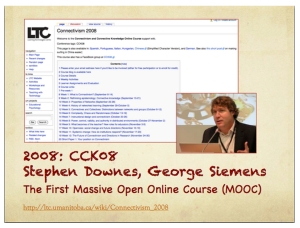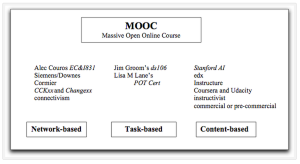The acronym MOOC often causes confusion as to what it means to be open but not massive, massive but not open, and online but not MOOC. It is a misnomer. For more details on the term MOOC as misnomer, you may follow David Wiley.
Given the huge media attention to some of the MOOCs offered by elite institutions like MIT and , Stanford and organizations like edX, Udacity, Coursera and Udemy, they are dubbed as MOOC in general. These MOOCs have structured content with video lectures, assignments and evaluations weaved into a tight-semester-like schedule. Most video lectures are embedded with an automatic system to test learners’ understanding as they work through the content. Some courses also experiment with peer assessment, providing a set rubric against which peers evaluate each other’s work. Of course, there are discussion forums to facilitate interaction with other participants of the course and to discuss course-related learning issues. But the central characteristics of these MOOCs are content-based and instructor-led lessons. They are named as xMOOC to differentiate it from the earlier version of MOOC which in turn got termed as cMOOC. The first xMOOCs was Stanford’s Artificial Intelligence by Peter Norvig and Sebastian Thrun of Google Corporation and Stanford University, respectively. It was offered in the fall of 2011 to about 160,000 enrolled students across the globe. Machine Learning, Introduction to Databases, and Introduction to Computer Science are other popular xMOOCs. There are hundreds of xMOOCs available in various fields of arts, humanities, science and technology.
with peer assessment, providing a set rubric against which peers evaluate each other’s work. Of course, there are discussion forums to facilitate interaction with other participants of the course and to discuss course-related learning issues. But the central characteristics of these MOOCs are content-based and instructor-led lessons. They are named as xMOOC to differentiate it from the earlier version of MOOC which in turn got termed as cMOOC. The first xMOOCs was Stanford’s Artificial Intelligence by Peter Norvig and Sebastian Thrun of Google Corporation and Stanford University, respectively. It was offered in the fall of 2011 to about 160,000 enrolled students across the globe. Machine Learning, Introduction to Databases, and Introduction to Computer Science are other popular xMOOCs. There are hundreds of xMOOCs available in various fields of arts, humanities, science and technology.
 cMOOC is connectivist MOOC which emphasizes on the personal and subject aspects of participants connected together to create meaning, build knowledge and navigate their own web of connections. Since these types of MOOOCs are personal and subjective, participants can set their own learning goals and type of engagement with others. The main focus is not on content but sharing ideas, being networked and connected. The first of this type of MOOC was the CCK08 – Connectivism and Connective Knowledge by George Siemens and Stephen Downes. (The linked website has a link to Dr. George Siemens’ video CCK08.) This course was opened up for free to anyone who wanted to participate in this. About 2300 students registered for this course. Several others followed the suit – PLENK2010, LAK11, MobiMOOC (2011), and eduMOOC (2011), and a repeat of CCK08 in 2009 & 2011, to name a few.
cMOOC is connectivist MOOC which emphasizes on the personal and subject aspects of participants connected together to create meaning, build knowledge and navigate their own web of connections. Since these types of MOOOCs are personal and subjective, participants can set their own learning goals and type of engagement with others. The main focus is not on content but sharing ideas, being networked and connected. The first of this type of MOOC was the CCK08 – Connectivism and Connective Knowledge by George Siemens and Stephen Downes. (The linked website has a link to Dr. George Siemens’ video CCK08.) This course was opened up for free to anyone who wanted to participate in this. About 2300 students registered for this course. Several others followed the suit – PLENK2010, LAK11, MobiMOOC (2011), and eduMOOC (2011), and a repeat of CCK08 in 2009 & 2011, to name a few.
 There are other MOOCs which are classified as task based MOOCs. These MOOCs are designed to complete specific tasks by participants. The participants may be guided by instruction materials, feedback and group works. ds106 Digital Story Telling is an example of this type. You may refer Lisa’s post which details the different types of MOOCs
There are other MOOCs which are classified as task based MOOCs. These MOOCs are designed to complete specific tasks by participants. The participants may be guided by instruction materials, feedback and group works. ds106 Digital Story Telling is an example of this type. You may refer Lisa’s post which details the different types of MOOCs
In addition to the above classification, Donald Clark categorizes MOOCs based on pedagogy. The list includes: transferMOOC, madeMOOC, synchMOOC, asynchMOOC, adaptiveMOOC, groupMOOC, connectivistMOOC, and miniMOOC.
Each type of MOOCs is produced for a specific context and purpose. Each of them offers a tremendous opportunity for learning. Each of them can enhance learning experience depending the type of engagement and knowledge one likes to experiment with. Understanding the background of each type of MOOCs, I believe, will better prepare the person to utilize them well.
